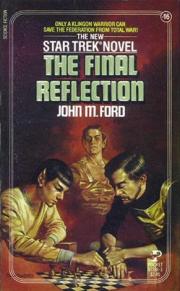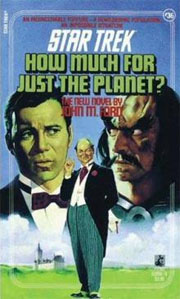As a television show, the original series of Star Trek focused on stories about Kirk and humanity. Some of the best Star Trek novels take advantage of this well-understood background to turn the readers’ attention to characters and races that were less thoroughly explored onscreen. John M. Ford’s World’s Apart series offers two excellent and very different examples of this. The Final Reflection and How Much for Just the Planet? were originally published in 1984 and 1987 respectively. The books were not linked at initial publication, but were hitched together when they were reprinted in 1999. The Final Frontier, which was ably reviewed by Jo Walton on this site in late January, represented an early effort to explore the Klingon Empire. How Much for Just the Planet? extends Ford’s exploration of Klingon culture by combining it with musical comedy.
The first time the Romulans appeared on Star Trek, the show could only afford a couple sets of ears and the rest of the Romulans had to wear big helmets. Since Klingon alien-ness in the original series was limited to being swarthy and willing to shoot people for no reason, Klingons were relatively inexpensive, which is almost certainly one of the reasons for the relatively frequent appearances of the Klingon race as villains of the week. As the alien race of convenience, the Klingons suffered from inconsistent characterization. In some episodes they relied on brute force and seemed to have a totalitarian political system with a high degree of personal risk and accountability. In other episodes, Klingon commanders seemed to operate independently and employed subtle, long-term strategies. The only important consistency was that, as the enemies of the Federation, the Klingons were metaphorically Soviet. Ford embraced the opportunities these inconsistencies offered for world-building, creating, in The Final Reflection, a Klingon approximation of The Hunt for Red October, which was published in the same year. The stories are not substantively similar, but the idea of seeing your enemy’s essential humanity and the uncertainty and danger inherent in international/intergalactic tensions bind them together thematically.
 If The Final Reflection is The Hunt for Red October, How Much for Just the Planet? Is The Mouse that Roared. Again, the stories are not substantively similar, but the humorous tone and the theme of exploiting intergalactic tension for the benefit of an otherwise vulnerable state bind the two together. In How Much for Just the Planet? a Federation Survey vessel and a Klingon ship discover Direidi, a planet in the Klingon-Federation neutral zone with OODLES of dilithium, basically simultaneously. Under the provisions of the Organian Treaty between the UFP and the Klingon Empire, this means that the two governments get to compete for the planet by demonstrating “the ability to develop the world in a peaceful and useful manner” with development rights being granted to “the party that best shows said ability.” The treaty does not make clear what role the indigenous population of the planet in question is supposed to play in this selection process, especially if, as in this case, they aren’t really keen on having their planet be useful to either party. Direidi’s answer to this problem makes extensive use of community theater.
If The Final Reflection is The Hunt for Red October, How Much for Just the Planet? Is The Mouse that Roared. Again, the stories are not substantively similar, but the humorous tone and the theme of exploiting intergalactic tension for the benefit of an otherwise vulnerable state bind the two together. In How Much for Just the Planet? a Federation Survey vessel and a Klingon ship discover Direidi, a planet in the Klingon-Federation neutral zone with OODLES of dilithium, basically simultaneously. Under the provisions of the Organian Treaty between the UFP and the Klingon Empire, this means that the two governments get to compete for the planet by demonstrating “the ability to develop the world in a peaceful and useful manner” with development rights being granted to “the party that best shows said ability.” The treaty does not make clear what role the indigenous population of the planet in question is supposed to play in this selection process, especially if, as in this case, they aren’t really keen on having their planet be useful to either party. Direidi’s answer to this problem makes extensive use of community theater.
It would be easy to summarize the remainder of the book as Glee in space. The production numbers are apparently spontaneous and lavishly produced. But this comparison ignores the intricately crafted story that runs both through and beneath a surface layer of escalating chaos. Behind the scenes, a group of writers and production staff are working frantically to make sure that all the characters play their parts and the resolution is believable. These characters are thinly veiled allusions to popular science fiction writers both an in-joke for devoted readers and a sly reminder that however outrageous this particular story seems, it works the way Star Trek has always worked.
The Final Reflection looked at the Klingon Empire through the eyes of extraordinary Klingons, who did extraordinary things. How Much for Just the Planet? looks at what it means to be Klingon through the eyes of Klingons in ordinary moments. Aperoki, the nerdy Klingon communications officer likes old Federation movies a little too much. Arizhel, the Klingon survey officer, talks about disappointing her parents with her career choices. A brief and hopeless romance between Arizhel and Captain Kaden vestai-Operai, is one of the best examples of the revealing nature of the mundane. In a rare, quiet moment they consider what their life together might be like, and realize that their empire’s current policies leave them with no plausible shared future.
Ford’s ideas about Klingons also had a limited future—they have been largely neglected in the accepted Klingon literature. Their omission from the canon is tragic and undeserved. The World’s Apart series is a much needed revelation of the potential of enhancing intergalactic understanding through a combination of traditional narratives and dinner theater.
Ellen Cheeseman-Meyer has been a Star Trek fan since the early 90s, but only started watching the series in 2009. She teaches history and reads a lot.










